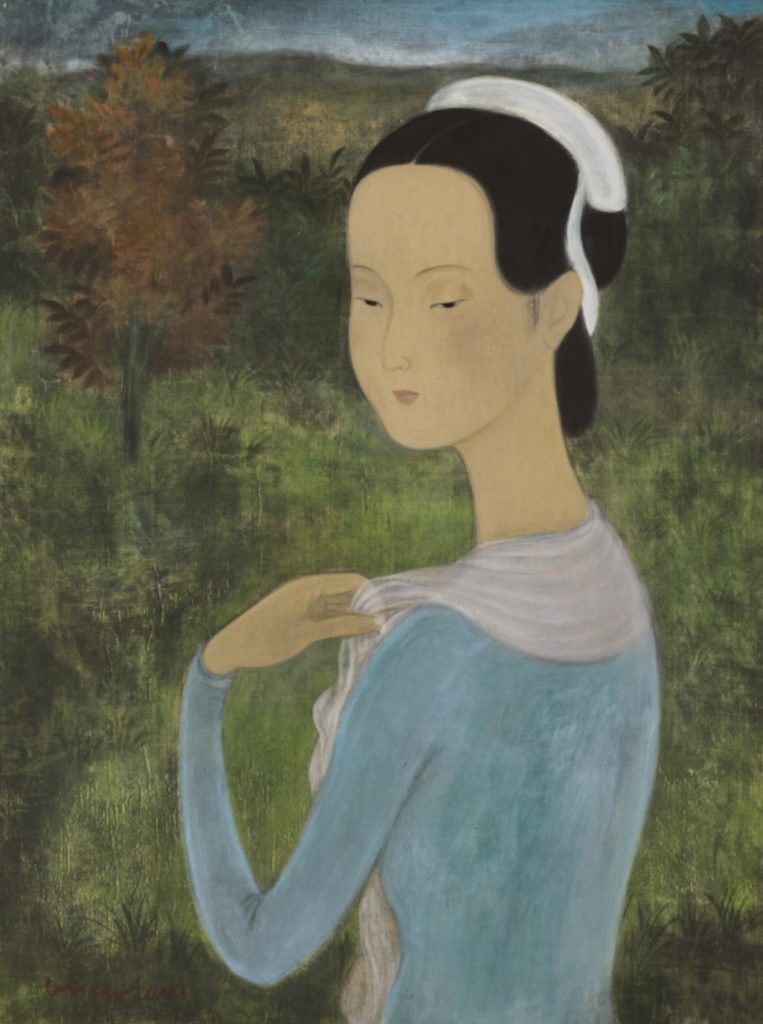Vu Cao Dam, circa 1939, « La Jeune Fille au Turban Blanc » (The Girl with the White Turban), or the certainty of choice
When Vu Cao Dam painted this sumptuous silk around 1939, he was living in Paris since 1931. His desire to taste the fervor of the “City of Light” – he was the first of all his fellow students at the Indochina School of Fine Arts to attempt the adventure – had been fulfilled. His participation in the Colonial Exhibition of 1931, in the Salons (notably the Independents, the French Artists, the Autumn Salons) and in the AGINDO events made him better known to a public of scholars. In 1938, he exhibited at the Galerie de la Muette, also in Paris. That same year, on August 11, he married Renée Appriou. She will be the absolute love of his life. They rented a modest house on rue Bertillon; Le Pho and Mai Thu came to live together in a nearby studio.
However, not everything is easy. If in Paris, the artistic supply and demand are endless, if an artist attracts attention, the economic situation remains difficult. The “crisis of “29”, which originated in the United States, has had a negative impact throughout the decade and the art world was affected. Vu Cao Dam lives sparingly from his art, which is nourished by his passion, his respect for others and his immense erudition. His exacerbated quest for knowledge of civilizations and individuals will be never underlined. His fascination for Khmer, Chinese Wei or Tang sculpture, his constant interest for the old masters – Clouet, Memling, Giotto among others – or for his contemporaries, notably Chagall, Marquet and Foujita, will remain intact throughout his life.
To take from the world what it has of better to embellish it: in our painting Vu Cao Dam, condenses this artistic step with a passion that transcends the artist.
This is confirmed by our “Young Girl with a White Turban”.

Michel Vu, son and fine expert of the painter, did us the honor to comment (May 4, 2023) our painting:
“I really like this painting.
[…]
… I notice the difference in technique between the representation of the person and that of the landscape which is much freer and announces his desire to “liberate” his painting, which he will do thereafter.
I particularly like the harmony of the colors”.
Our painting, innovative, testifies to a change of style in the artist that reflects his new state of mind.
The “much freer” landscape in the background is built on a subtle cameo of green. Freedom, the real one, wants to be universal, that’s why the artist offers us this untypical landscape, not located. One of those that can be attributed to many places in the world. None of these fine arequiers or banana trees with large golden leaves, of these sugar loaves of the Middle Region, shaded or golden. No rice fields, no jungle, no architectural or furniture elements that localize and therefore identify contemporary representations (especially in lacquer) in Vietnam. No. We could be in Europe or in Asia. And the plurality of choices offered to us by the artist translates his universality.
The sky, in the background, is a further example. There again, a subtle cameo of blues recounts the tumultuous aspect. And there again, beyond the very high horizon (stylistically very Asian) the universality of the sky. A sky from everywhere because it is from nowhere. Here again a particularly successful “harmony” of colors.
The earth and the sky.
Those are the jewel case of the young woman.
She is the quintessence of Vietnam felt by Vu Cao Dam.
Her turban, her ao dai, her shawl are proof of this. All elements that appeared – in this form – in the 30s in Vietnam. Years that the artist has lived at a distance. It is not insignificant that Vu Cao Dam has titled her work with one of these attributes so feminine and so Vietnamese.
Let’s look at her: she is standing in front of us. We would find her a bit condescending if her seductive but already distant gaze, her haughty and slanting pose and her loose gesture did not add up to such seductive elegance.
She keeps us at a distance. Vu Cao Dam is not only an immense painter, he is also the greatest Vietnamese sculptor. And here he “sculpts” as much as he paints – admirably – the gesture of this woman with a high and graceful neck: she readjusts her shawl with an elegant hand, gives us one last look and turns away from us. To face the world to which she turned her own back. Her destiny.
The white turban, which contrasts strongly with the black ink of the hair, the blue ao dai, the transparent tulle all in subtle washes and nuanced tones will be from now on a quotation in the work of the painter more than a claim.
Transmutation of art: this young woman is him.
An artist has only one homeland: his art. In this year 1939 Vu Cao Dam became certain of his choice.
Jean-François Hubert